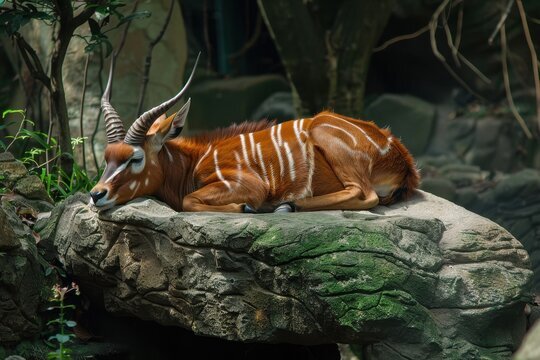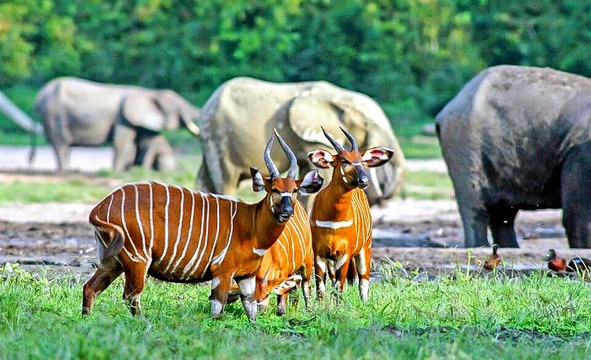Introduction to the Bongo (Tragelaphus eurycerus)
The Bongo (Tragelaphus eurycerus)、 bongo (antelope)、bongo antelope bull.is a large and striking antelope species endemic to the forests of sub-Saharan Africa. Notable for its reddish-brown coat adorned with vertical white stripes, and its impressive spiral-shaped horns, the Bongo is one of the most beautiful and enigmatic members of the Tragelaphus genus. In this article, we will delve into the Bongo’s scientific classification, detailed morphology, ecological role, behavioral patterns, conservation status, and current efforts to protect the species.It is the only tragelaphid in which both sexes have horns. Bongos have a complex social interaction and are found in African dense forest mosaics. They are the third-largest antelope in the world.
The Bongo is a member of the family Bovidae, subfamily Bovinae, and genus Tragelaphus. Here’s the full taxonomic classification:
Kingdom: Animalia
Phylum: Chordata
Class: Mammalia
Order: Artiodactyla
Family: Bovidae
Subfamily: Bovinae
Genus: Tragelaphus
Species: T. eurycerus
This species is divided into two subspecies:
Western Bongo (T. e. eurycerus): Found in West and Central Africa, including countries like Gabon, Cameroon, and the Central African Republic.
Eastern Bongo (T. e. isaaci): Inhabits the mountainous regions of Kenya, particularly the Aberdare Range and Mount Kenya.
The Bongo was first described by William Ogilby in 1837, who observed its distinct markings and large, spiral horns. The name "Bongo" is believed to derive from the Kele language spoken in Gabon, where the species is found in large numbers. Over the years, the taxonomy of Bongos has remained relatively stable, with two subspecies recognized based on geographic distribution and slight differences in morphology.

Bongos are among the largest antelopes in Africa, with remarkable features that make them easily distinguishable from other species.
Males: Males typically stand at 1.1–1.3 meters (3.6–4.3 feet) at the shoulder and weigh between 220 to 405 kilograms (485 to 893 pounds).
Females: Females are smaller, measuring 1.0–1.2 meters (3.3–3.9 feet) at the shoulder and weighing 150 to 235 kilograms (331 to 518 pounds).
The Bongo’s reddish-brown coat is marked with distinct white and yellow vertical stripes, which help camouflage the animal in the dense forests it inhabits. The coat is thick and coarse, especially during the rainy season.
Horns: Both males and females have spiral horns, with males possessing larger and more pronounced horns that can reach up to 99 cm (39 inches). The horns curve slightly forward and twist, making them a unique feature for identification.
Facial Features: Bongos have a distinctive white face mask, with a dark stripe running from the nose to the eyes, creating a bold contrast against their reddish coat.
Limbs: Their legs are slender but strong, allowing for swift movement through dense underbrush and providing an advantage in escaping predators.
Tail: The tail is short and tufted, with a length ranging between 45 to 65 cm (18 to 26 inches).
The Bongo is a forest-dwelling species, found primarily in the rainforests of West and Central Africa. Their range spans several countries in sub-Saharan Africa, where they are typically found in dense, tropical forests, though the Eastern Bongo has a more limited range restricted to the mountainous regions of Kenya.
Rainforests: Bongos prefer lowland tropical forests with thick vegetation. They are highly adapted to these habitats and are rarely found in open savannahs or grasslands.
Mountainous Forests: The Eastern Bongo is found in montane forests, particularly in the Aberdare Range and around Mount Kenya, where the habitat is cooler and more rugged.
Altitudinal Range: The Eastern Bongo can be found at altitudes ranging from 1,500 to 3,000 meters (4,920 to 9,840 feet), while the Western Bongo occupies lower altitudes, typically from sea level to 1,500 meters (4,920 feet).
Bongos are nocturnal and crepuscular creatures, primarily active at night and during the early morning and late evening hours, when temperatures are cooler and predators are less active. They are usually solitary or found in small family groups, although their social structure can vary based on the time of year.
Solitary Males: Adult males tend to be solitary, with territorial behavior observed during mating seasons.
Family Groups: Females and juveniles form small groups of 6 to 8 individuals, although group sizes can increase during favorable food conditions.
Vocalizations: Bongos are generally silent but are known to make soft grunting or snorting sounds. Their vocalizations are used primarily for communication between mothers and calves.
Movement: Bongos are swift and agile, adept at navigating dense forest environments. Their agility helps them evade predators and forage for food in difficult terrain.
Herbivorous Diet: Bongos are browsers, consuming a variety of vegetation, including leaves, fruits, bamboo, and tree bark. Their long prehensile tongues help them grasp and manipulate vegetation.
Salt Licks: Like many herbivores, Bongos visit salt licks to replenish vital minerals, which are often deficient in their diet.
The Bongo has a relatively slow reproductive rate compared to other antelopes. Females typically give birth to a single calf after a gestation period of 9.5 months. The calf is born in a concealed area to avoid predators and is kept hidden for several weeks before it begins to follow the mother.
Breeding Season: The mating season generally occurs during the rainy months when food availability is higher.
Calf Rearing: The calf remains close to the mother for the first few months of life, during which it is nursed and protected. They are typically weaned by 6 to 9 months of age.

Western Bongo: The Western Bongo is classified as Near Threatened by the International Union for Conservation of Nature (IUCN). Although still present in several protected areas, their populations are decreasing due to habitat loss and poaching.
Eastern Bongo: The Eastern Bongo is classified as Critically Endangered by the IUCN, with fewer than 100 individuals estimated to remain in the wild. Its range is confined to a small, fragmented habitat in central Kenya, making it particularly vulnerable.
Habitat Loss: Deforestation and agricultural expansion are the primary drivers of habitat destruction, forcing Bongos to retreat into smaller, more fragmented forest patches.
Poaching: The Bongo’s horns, skin, and meat are highly prized, leading to illegal hunting and poaching. While the Bongo has not been heavily hunted for trophies like other antelopes, poaching for bushmeat remains a significant threat.
Climate Change: Altered rainfall patterns and increasing temperatures may impact the forest ecosystems that Bongos rely on, potentially affecting their food sources and overall habitat quality.
Leopards and hyenas are the primary natural predators of the Bongo, particularly when they are young. However, adult Bongos are generally safe from predation due to their size and agility.
Conservation efforts for the Bongo have increased over the past decades, with a focus on protecting both the Western and Eastern Bongo populations.
Captive Breeding Programs: Institutions like North American Zoos and European Zoos have established breeding programs for the Bongo to ensure genetic diversity and to contribute to the overall population recovery.
Reintroduction Projects: The Mount Kenya Wildlife Conservancy has undertaken efforts to reintroduce the Eastern Bongo into protected forest habitats. In some areas, such as the Aberdare Range, dedicated reintroduction efforts are seeing slow but positive results.
Anti-poaching Patrols: Increased patrolling in key habitats like the Mau Forest and Mount Kenya National Park has been effective in curbing poaching activities.
Community Involvement: Conservation programs are increasingly involving local communities in protecting Bongo habitats by providing alternative livelihoods through ecotourism and sustainable forest management practices.
| Species | Size (Height) | Size (Weight) | Geographic Range | Conservation Status |
|---|---|---|---|---|
| Common Eland | 1.5–1.8 m | 400–900 kg | Central & Southern Africa | Near Threatened |
| Greater Kudu | 1.0–1.3 m | 190–270 kg | Eastern & Southern Africa | Least Concern |
| Nyala | 1.0–1.3 m | 55–140 kg | Southern Africa | Least Concern |
| Bongo (Western) | 1.1–1.3 m | 150–405 kg | Central Africa | Near Threatened |
| Bongo (Eastern) | 1.1–1.3 m | 150–350 kg | Kenya (Mountain Areas) | Critically Endangered |
The Bongo is a majestic and ecologically significant antelope, but it faces significant challenges. Conservation initiatives are crucial to preserving the species and its habitat. By focusing on habitat restoration, anti-poaching measures, and community-based conservation, there is hope for the survival of the Bongo in the wild. Ensuring that this magnificent species thrives is not only vital for maintaining the health of Africa’s rainforests but also for supporting the biodiversity of the entire region.
animal tags: Bovidae
We created this article in conjunction with AI technology, then made sure it was fact-checked and edited by a Animals Top editor.